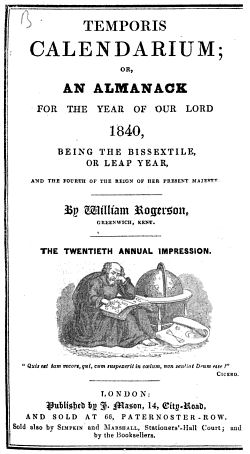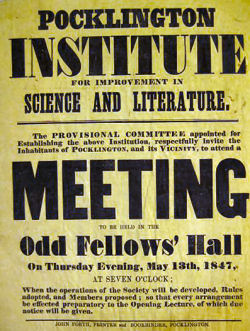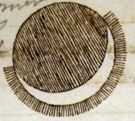|
 His obituary appeared in the Yorkshire Gazette on 28th May 1853 His obituary appeared in the Yorkshire Gazette on 28th May 1853
"William Rogerson was born in Pocklington on 6th May, 1796, the son of William Rogerson and Grandson of William, all born and raised in the town. Grandfather William was one of the first to join the Wesleyan society and a founder member of the earliest Wesleyan Chapel in Chapmangate and personal friend of John Wesley whom attended Pocklington on many occasions. In 1818, grandfather William died and was interred in the burial ground attached to the Wesleyan Chapel in Pocklington. His nickname was "Old Billy", and was an odd character as 12 years before he died, the old man had his coffin made, painted it black with breastplate and added other furniture decoration. After the death of his grandfather, with whom William Rogerson and his younger brother Thomas had been brought up, he inherited a large sum of money (£1200). His Grandfather had specified his fortune be equally divided between the two grandsons. Strange to say that just one day before Thomas was due to inherit his half of the inheritance, he mysteriously died, and William inherited the whole amount. "
Graham Dolan has created an excellent biography of William Rogerson on the Royal Observatory website. From his research it is believed there is insufficient evidence to support the biography above for the inheritance and the value of the Rogerson estate.
William was inspired by a group of local amateur scientists who used to meet in Pocklington and had an  interest in astronomy and the heavens. These included Thomas Cooke of Allerthorpe (future telescope maker in York), William Watson of Seaton Ross (Mapmaker and Sundial maker), John Smith of Bielby (sundial maker and amateur astronomer) and William Richardson of Pocklington (future assistant to the Astronomer Royal in Greenwich) and who married William Rogerson's sister. William studied mathematics and all aspects of Astronomy and became an intimate friend of Mr Henry Andrews of Royston, Herts. Henry was for upwards of 43 years the compiler of the Old Moore's Almanack and died in 1820 in the 75th year of his age. During the year 1819 the Wesleyan Society had the idea to publish an Almanack and as William was a loyal methodist and known astronomer and mathematician, he was selected to produce the almanack. According to his obituary* published in the Yorkshire Gazette of 28th May, 1853, he took the coach from the New Inn to Hull in July 1819, from there made his way to Grimsby where he met a kindred spirit and most excellent man, George Herring. Together they created the first few issues of the almanack, when William fell in love with George's sister, and married her in Grimsby in 1824. In 1826 he was appointed one of the calculators of the Royal Observatory in Greenwich, by the Astronomer Royal John Pond, and worked with Professor Faraday (eminent pioneer of magnetism and electricity). One writer in the Wesleyan Methodist Magazine** writes of meeting this remarkable man and who had read him a poem descriptive of his first journey from Pocklington to London on foot. which poem he kindly wrote down for him, using to his astonishment the right and left hand alternatively. interest in astronomy and the heavens. These included Thomas Cooke of Allerthorpe (future telescope maker in York), William Watson of Seaton Ross (Mapmaker and Sundial maker), John Smith of Bielby (sundial maker and amateur astronomer) and William Richardson of Pocklington (future assistant to the Astronomer Royal in Greenwich) and who married William Rogerson's sister. William studied mathematics and all aspects of Astronomy and became an intimate friend of Mr Henry Andrews of Royston, Herts. Henry was for upwards of 43 years the compiler of the Old Moore's Almanack and died in 1820 in the 75th year of his age. During the year 1819 the Wesleyan Society had the idea to publish an Almanack and as William was a loyal methodist and known astronomer and mathematician, he was selected to produce the almanack. According to his obituary* published in the Yorkshire Gazette of 28th May, 1853, he took the coach from the New Inn to Hull in July 1819, from there made his way to Grimsby where he met a kindred spirit and most excellent man, George Herring. Together they created the first few issues of the almanack, when William fell in love with George's sister, and married her in Grimsby in 1824. In 1826 he was appointed one of the calculators of the Royal Observatory in Greenwich, by the Astronomer Royal John Pond, and worked with Professor Faraday (eminent pioneer of magnetism and electricity). One writer in the Wesleyan Methodist Magazine** writes of meeting this remarkable man and who had read him a poem descriptive of his first journey from Pocklington to London on foot. which poem he kindly wrote down for him, using to his astonishment the right and left hand alternatively.
  A gravestone in Pocklington churchyard was commissioned by William to commemorate his young brother. It reads "In Memory of Joseph Rogerson youngest son of Wm. And As. Rogerson who died of the confluent small pox September 6th and interred on September 7th 1820. Aged 3 years. During his sufferings (which were extreme) his patience and good nature were such as will leave a lasting impression on the minds of his afflicted parents." The curious symbol on the gravestone was recorded by Watson in his journal and about it wrote "This child was intered the day of the great eclipse of the sun therefore his brother the astronomer caused a delineation of that eclipse be put on his gravestone". Wikipedia has a description of it here. A gravestone in Pocklington churchyard was commissioned by William to commemorate his young brother. It reads "In Memory of Joseph Rogerson youngest son of Wm. And As. Rogerson who died of the confluent small pox September 6th and interred on September 7th 1820. Aged 3 years. During his sufferings (which were extreme) his patience and good nature were such as will leave a lasting impression on the minds of his afflicted parents." The curious symbol on the gravestone was recorded by Watson in his journal and about it wrote "This child was intered the day of the great eclipse of the sun therefore his brother the astronomer caused a delineation of that eclipse be put on his gravestone". Wikipedia has a description of it here.
William moved to 19, Great George Street, Greenwich where he lived until his death of bronchitis in April 1853. William published the almanack annually for the rest of his days and for 35 years was also a local Methodist preacher. He was described in his obituary as "an upright and honourable man; but he had his crotchets and singularities". Mr Rogerson's almanack called the "Temporis Calendarium", continued to be published by the Methodist Society until 1850 when the author joined the reform movement and the publication moved to other hands. He was a prolific writer for many journals and papers on Astronomy. He was described as a man of mild and peaceable disposition, kind in all the social relations of life, an excellent and kind hearted man, a well disposed Christian and one of the best practical mathematicians and astronomers which the century had produced.
* Yorkshire Gazette, 28th May, 1853.
** Wesleyan Methodist Magazine, 119, (1896: Dec) p.928
*** William Rogerson Biography - The Royal Observatory Website
|

